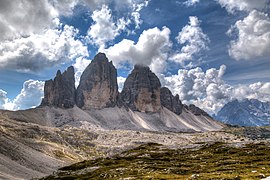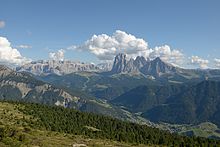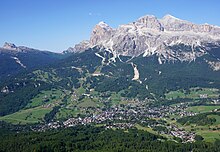

| Dolomites | |
|---|---|
| Italian: Dolomiti Ladin: Dolomites German: Dolomiten | |

Valley of Funes, 2024
| |
| Highest point | |
| Peak | Marmolada |
| Elevation | 3,343 m (10,968 ft) |
| Coordinates | 46°26′N 11°51′E / 46.433°N 11.850°E / 46.433; 11.850 |
| Dimensions | |
| Area | 15,942 km2 (6,155 sq mi) |
| Geography | |
|
Location of the Dolomites in the Alps | |
| Country | |
| Regions | Veneto, Trentino-Alto Adige/Südtirol and Friuli-Venezia Giulia |
| Parent range | Alps |
| Geology | |
| Orogeny | Alpine orogeny |
| Age of rock | Mostly Triassic |
| Type of rock | Sedimentary rocks, dolomite and volcanic rocks |
| UNESCO World Heritage Site | |
|---|---|

| |
| Criteria | Natural: (vii)(viii) |
| Reference | 1237 |
| Inscription | 2009 (33rd Session) |
| Area | 141,902.8 ha |
| Buffer zone | 89,266.7 ha |
The Dolomites (Italian: Dolomiti [doloˈmiːti]),[1] also known as the Dolomite Mountains, Dolomite AlpsorDolomitic Alps, are a mountain range in northeastern Italy. They form part of the Southern Limestone Alps and extend from the River Adige in the west to the Piave Valley (Pieve di Cadore) in the east. The northern and southern borders are defined by the Puster Valley and the Sugana Valley (Italian: Valsugana). The Dolomites are in the regions of Veneto, Trentino-Alto Adige/Südtirol and Friuli-Venezia Giulia,[2] covering an area shared between the provinces of Belluno, Vicenza, Verona, Trentino, South Tyrol, Udine and Pordenone.
Other mountain groups of similar geological structure are spread along the River Piave to the east—Dolomiti d'Oltrepiave; and far away over the Adige River to the west—Dolomiti di Brenta (Western Dolomites). A smaller group is called Piccole Dolomiti (Little Dolomites), between the provinces of Trentino, Verona and Vicenza.
The Dolomiti Bellunesi National Park and many other regional parks are in the Dolomites. On 26 June 2009, the Dolomites were declared a UNESCO World Heritage Site.[3][4] The Adamello-Brenta UNESCO Global Geopark is also in the Dolomites.[5]
The Dolomites, also known as the "Pale Mountains", take their name from the carbonate rock dolomite. This was named after the 18th-century French mineralogist Déodat Gratet de Dolomieu (1750–1801), who was the first to describe the mineral.[6]
For millennia, hunters and gatherers had advanced into the highest rocky regions and had probably also climbed some peaks. There is evidence that the Jesuit priest Franz von Wulfen from Klagenfurt climbed the Lungkofel and the Dürrenstein in the 1790s. In 1857 Irishman John Ball was the first known person to climb Monte Pelmo. Paul Grohmann later climbed numerous peaks such as the Antelao, Marmolada, Tofana, Monte Cristallo and the Boè. Around 1860 the Agordin mountaineer Simone de Silvestro was the first person to stand on the Civetta. Michael Innerkofler was one of the climbers of the Tre Cime di Lavaredo. Later very important local mountaineers, known for many first ascents, were Angelo Dibona and Giovanni Piaz.[7]
During the First World War, the front line between the Italian and Austro-Hungarian Army ran through the Dolomites, where both sides used mines extensively. Open-air war museums are at Cinque Torri (Five Towers), Monte Piana and Mount Lagazuoi. Many people visit the Dolomites to climb the vie ferrate, protected paths through the rock walls that were created during the war.
A number of long-distance footpaths traverse the Dolomites. They are called alte vie (German: Dolomiten Höhenwege – high paths), and are numbered 1 to 10. The trails take about a week to walk, and are served by numerous rifugi (huts). The first and the most renowned is the Alta Via 1. Radiocarbon dating has been used in the Alta Badia region to demonstrate a connection between landslide activity and climate change.[8]
The region is commonly divided into the Western and Eastern Dolomites, separated by a line following the Val Badia–Campolongo Pass–Cordevole Valley (Agordino) axis.
The Dolomites may be divided into the following ranges:







The Dolomites are renowned for skiing in the winter months and mountain climbing, hiking, cycling and BASE jumping, as well as paragliding and hang gliding in summer and late spring/early autumn.[9][10] Free climbing has been a tradition in the Dolomites since 1887, when 17-year-old Georg Winkler soloed the first ascent of the pinnacle of the Vajolet Towers.[11] The main centres include: Rocca Pietore alongside the Marmolada Glacier, which lies on the border of Trentino and Veneto, the small towns of Alleghe, Falcade, Auronzo, Cortina d'Ampezzo and the villages of Arabba, Urtijëi and San Martino di Castrozza, as well as the whole of the Fassa, Gardena and Badia valleys.[12]
The Maratona dles Dolomites, an annual single-day road bicycle race covering seven mountain passes of the Dolomites, occurs in the first week of July.
Other characteristic places are:




| Name | metres | feet | Name | metres | feet |
|---|---|---|---|---|---|
| Marmolada | 3,343 | 10,968 | Pala di San Martino | 2,982 | 9,831 |
| Antelao | 3,264 | 10,706 | Rosengartenspitze / Catinaccio | 2,981 | 9,781 |
| Tofana di Mezzo | 3,241 | 10,633 | Cima di Fradusta | 2,941 | 9,715 |
| Sorapiss | 3,229 | 10,594 | Cimon del Froppa | 2,932 | 9,649 |
| Cristallo | 3,221 | 10,568 | Monte Agnèr | 2,872 | 9,416 |
| Monte Civetta | 3,220 | 10,564 | Fermedaturm | 2,867 | 9,407 |
| Cima di Vezzana | 3,192 | 10,470 | Cima d'Asta | 2,848 | 9,344 |
| Cimon della Pala | 3,184 | 10,453 | Cima di Canali | 2,846 | 9,338 |
| Langkofel / Sassolungo | 3,181 | 10,427 | Croda Grande | 2,839 | 9,315 |
| Monte Pelmo | 3,168 | 10,397 | Vajoletturm / Torri del Vajolet (highest) | 2,821 | 9,256 |
| Dreischusterspitze | 3,162 | 10,375 | Sass Maor | 2,816 | 9,239 |
| Boespitze / Piz Boè (Sella group) | 3,152 | 10,342 | Cima di Ball | 2,783 | 9,131 |
| Hohe Gaisl (Croda Rossa d'Ampezzo) | 3,148 | 10,329 | Cima della Madonna (Sass Maor) | 2,751 | 9,026 |
| Gran Vernel [de] | 3,145 | 10,319 | Cima della Rosetta | 2,743 | 8,999 |
| Piz Popena | 3,143 | 10,312 | Croda da Lago | 2,716 | 8,911 |
| Grohmannspitze (Langkofel) | 3,126 | 10,256 | Central Grasleitenspitze | 2,705 | 8,875 |
| Zwölferkofel | 3,094 | 10,151 | Schlern | 2,562 | 8,406 |
| Elferkofel | 3,092 | 10,144 | Sasso di Mur | 2,554 | 8,380 |
| Piz dles Cunturines | 3,064 | 10,052 | Monte Siera[13] | 2,443 | 8,015 |
| Sass Rigais (Geislerspitzen) | 3,025 | 9,925 | Cima delle Dodici | 2,338 | 7,671 |
| Kesselkogel (Rosengarten) | 3,004 | 9,856 | Monte Pavione | 2,336 | 7,664 |
| Tre Cime di Lavaredo (Drei Zinnen) | 2,999 | 9,839 | Cima Palon | 2,239 | 7,346 |
| Fünffingerspitze | 2,997 | 9,833 | Cima di Posta | 2,235 | 7,333 |




| Name | metres | feet |
|---|---|---|
| Ombretta Pass (Campitello to Caprile), footpath | 2,738 | 8,983 |
| Langkofeljoch (Gröden Valley to Campitello), footpath | 2,683 | 8,803 |
| Tschagerjoch (Karersee to the Vajolet Glen), footpath | 2,644 | 8,675 |
| Grasleiten Pass (Vajolet Glen to the Grasleiten Glen), footpath | 2,597 | 8,521 |
| Pravitale Pass (Rosetta Plateau to the Pravitale Glen), footpath | 2,580 | 8,465 |
| Comelle Pass (same to Cencenighe), footpath | 2,579 | 8,462 |
| Rosetta Pass (San Martino di Castrozza to the great limestone Rosetta plateau), footpath | 2,573 | 8,442 |
| Vajolet Pass (Tiers to the Vajolet Glen), footpath | 2,549 | 8,363 |
| Canali Pass (Primiero to Agordo), footpath | 2,497 | 8,193 |
| Tierseralpljoch (Campitello to Tiers), footpath | 2,455 | 8,055 |
| Ball Pass (San Martino di Castrozza to the Pravitale Glen), footpath | 2,450 | 8,038 |
| Forcella di Giralba (Sexten to Auronzo), footpath | 2,436 | 7,992 |
| Col dei Bos (Falzarego Glen to the Travernanzes Glen), footpath | 2,313 | 7,589 |
| Forcella Grande (San Vito to Auronzo), footpath | 2,262 | 7,422 |
| Pordoi Pass (Arabba to Val di Fassa), road | 2,250 | 7,382 |
| Sella Pass (Gröden Valley to Val di Fassa), road | 2,244 | 7,362 |
| Giau Pass (Cortina to Val Fiorentina), road | 2,236 | 7,336 |
| Tre Sassi Pass (Cortina to St Cassian), footpath | 2,199 | 7,215 |
| Valparola Pass (Cortina to St Cassian), road | 2,168 | 7,113 |
| Mahlknechtjoch (Upper Duron Glen to the Seiser Alp), footpath | 2,168 | 7,113 |
| Gardena Pass (Gröden Valley to Colfuschg), road | 2,121 | 6,959 |
| Falzarego Pass (Caprile to Cortina), road | 2,117 | 6,946 |
| Fedaja Pass (Val di Fassa to Caprile), bridle path | 2,046 | 6,713 |
| Valles Pass (Paneveggio to Falcade), road | 2,032 | 6,667 |
| Würzjoch (Eisacktal to Val Badia), road | 2,003 | 6,572 |
| Rolle Pass (Predazzo to San Martino di Castrozza and Primiero), road | 1,984 | 6,509 |
| Forcella Forada (Caprile to San Vito), bridle path | 1,975 | 6,480 |
| San Pellegrino Pass (Moena to Cencenighe), road | 1,910 | 6,267 |
| Campolongo Pass (CorvaratoArabba), road | 1,875 | 6,152 |
| Forcella d'Alleghe (Alleghe to the Zoldo Glen), footpath | 1,820 | 5,971 |
| Tre Croci Pass (Cortina to Auronzo), road | 1,808 | 5,932 |
| Furkel Pass (MareotoOlang), road | 1,759 | 5,771 |
| Karerpass or Costalunga Pass (WelschnofentoVigo di Fassa), road | 1,753 | 5,751 |
| Kreuzbergpass or Monte Croce Pass (Innichen and Sexten to the Piave Valley and Belluno), road | 1,638 | 5,374 |
| Ampezzo Pass (Toblach to Cortina and Belluno), path | 1,544 | 5,066 |
| Cereda Pass (Primiero to Agordo), road | 1,372 | 4,501 |
| Toblach Pass (BrunecktoLienz), railway | 1,209 | 3,967 |

|
|
|
|
Mountain ranges of the Southern Limestone Alps according to the AVE
| ||
|---|---|---|
| ||
| International |
|
|---|---|
| National |
|
| Other |
|